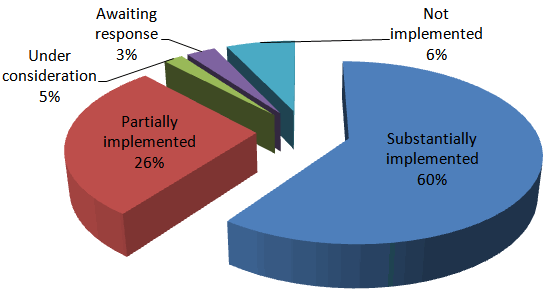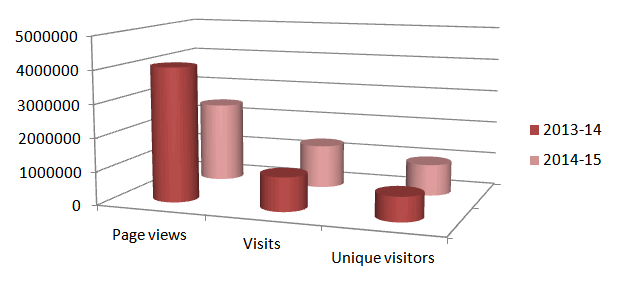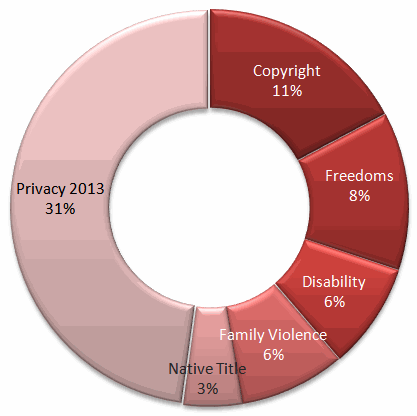27.10.2015
The ALRC measures the success of Program 1 in delivering its outcome through the following key performance indicators:
- implementation of ALRC reports by Government and other bodies, substantially or partially, over time;
- the number of court or tribunal decisions that cite ALRC reports;
- the number of submissions to each inquiry;
- the number of visitors to the website;
- the number of presentations and speaking engagements about ALRC inquiries;
- the number of media mentions of the ALRC and its work.
Table 4: Key achievements 2014–15
Program 1 | Target | Actual |
Implementation of reports—substantially or partially implemented | 85% | 86% |
Citations in courts or tribunal decisions | 50 | 77 |
Submissions received | 250 | 150 |
Visitors to website | >250,000 | 950,406 |
Presentations and speaking engagements | 25 | 11 |
Media mentions | 250 | 286 |
Implementation of reports
The ALRC has no direct role in implementing its recommendations. There is no statutory requirement for the Australian Government to respond formally to ALRC reports. However, the ALRC monitors major developments in relation to issues covered in its past reports, and assesses the level of implementation that those reports have achieved. It is not uncommon for implementation to occur some years after the completion of a report.
The ALRC considers that a report is substantially implemented when the majority of the report’s key recommendations have been implemented by those to whom the recommendations are directed. Partial implementation refers to implementation of at least some recommendations of an ALRC report.
The term ‘under consideration’ applies to reports that are under active consideration by the Australian Government. ‘Awaiting response’ refers to reports that have been completed within the past ten years, in relation to which the ALRC is yet to receive a formal response from the Government.
The levels of implementation of all ALRC reports are as follows:
- 60% are substantially implemented;
- 26% are partially implemented;
- 5% are under consideration;
- 3% are awaiting response; and
- 6% have not been implemented.
These figures represent an overall implementation rate for ALRC reports of 86%, as compared to 88% reported in 2013–14. The Government has yet to respond to a number of recently completed ALRC reports, including Making Inquiries: A New Statutory Framework (ALRC Report 111, 2010); Secrecy Laws and Open Government (ALRC Report 112, 2010); Copyright and the Digital Economy (ALRC Report 122, 2014); Serious Invasions of Privacy in the Digital Era (ALRC Report 123, 2014); Equality, Capacity and Disability in Commonwealth Laws (ALRC Report 124, 2014); and Connection to Country: Review of the Native Title Act 1993 (Cth) (ALRC Report 126, 2015).
Implementation status of ALRC reports as at 30 June 2015

Appendix F provides a detailed update on action in relation to ALRC reports during 2014–15.
Appendix G provides a brief overview of the implementation status of all 86 reference-related ALRC reports.
Court citations
Past ALRC reports are cited by Australian courts and tribunals as well as in numerous academic articles and other publications.
During 2014–15, there were at least 77 mentions of ALRC reports in the judgments of federal, state and territory courts. These included citation in three cases in the High Court of Australia, 17 in the Federal Court of Australia and other federal courts, 55 in state and territory Supreme Courts or Courts of Appeal and cases in the Land Court of Queensland and Administrative Appeals Tribunal.
The total number of citations is similar to the number of judgments from Australian courts and tribunals referring to ALRC reports in 2013–14. Historically, the ALRC report most often cited in Australian courts has been Evidence(Interim) (ALRC Report 26, 1985). More recently, Uniform Evidence Law (ALRC Report 102, 2006) has also attracted many citations. These reports are frequently cited because their text is an important secondary source assisting the judiciary in interpreting provisions of the Evidence Act 1995 (Cth) and state and territory uniform Evidence Acts.
Other reports of enduring interest to litigants and courts are Insurance Contracts (ALRC Report 20, 1982); General Insolvency Inquiry (ALRC Report 45, 1988); and Collective Investments: Other People’s Money (ALRC Report 65, 1992).
The report Genes and Ingenuity: Gene Patenting and Human Health (ALRC Report 99, 2004) was significant to the conclusions of the Full Court of the Federal Court in D’Arcy v Myriad Genetics Inc [2014] FCAFC 115, considering the patentability of isolated nucleic acid sequences, that is, nucleic acid (DNA or RNA). At the end of the reporting period, judgment in an appeal from this decision by the High Court was pending.
In the reporting period, a number of more recent reports were also cited in courts, including Serious Invasions of Privacy in the Digital Era (ALRC Report 123, 2014); Classification—Content Regulation and Convergent Media (ALRC Report 118, 2012); and Managing Discovery: Discovery of Documents in Federal Courts (ALRC Report 115, 2011).
A list of these court and tribunal citations is provided at Appendix H.
Submissions
The number of submissions received by the ALRC is a measure of public engagement with its work and the extent to which the consultation papers have stimulated debate and discussion. However, the number of submissions received for any inquiry is also influenced by its subject matter—particular inquiries are likely to generate a greater, broader degree of public interest and participation than others.
Table 5: Submissions received 2014–15
Consultation paper | Submissions closing date | Submissions received during reporting period |
Equality, Capacity and Disability in Commonwealth Laws (DP 81) | 30 June 2014 | 27 |
Review of the Native Title Act 1993 (DP 82) | 18 December 2014 | 41 |
Traditional Rights and Freedoms—Encroachments by Commonwealth Laws (IP 46) | 27 February 2015 | 82 |
Total submissions received |
| 150 |
ALRC website
The ALRC website is a pivotal communication tool for the ALRC and a law reform resource for the wider public. The ALRC strives to continually build value into the website, both in terms of providing useful and accessible content relevant to stakeholders and researchers, and utilising its functionality as an online consultation tool.
Key website metrics for 2014–15:
- visits = 1,311,041
- page views = 2,431,057
- unique visitors = 950,406
These metrics represent, compared to the 2013–14 reporting period:
- 28% increase in visits
- 39% decrease in page views*
- 30% increase in unique visitors
* In July 2014 the ALRC upgraded its CMS, which altered the way in which page views are counted. This means figures for this year do not reflect a true comparison, but moving forward will reflect the real value.
Comparison of website traffic: August–June in 2013–14 and 2014–15

ALRC website statistics provide evidence that it is not just in implementation that the ALRC makes a significant contribution to legal frameworks in Australia.
In 2014–15, the top five reports accessed by PDF downloads were
1. Serious Invasions of Privacy in the Digital Era (ALRC Report 123)
2. Recognition of Aboriginal Customary Laws (ALRC Report 31)
3. Family Violence—A National Legal Response (ALRC Report 114)
4. Uniform Evidence Law (ALRC Report 102)
5. Copyright and the Digital Economy (ALRC Report 122)
The inclusion in this list of the Uniform Evidence Report from 2006 and the Aboriginal Customary Laws Report from 1986 illustrates the enduring value of the ideas, discussion and research contained in these landmark reports.
Presentations and speaking engagements
Presenting at public conferences, seminars and Parliamentary inquiries ensures that the work of the ALRC is publicly debated and discussed. During 2014–15, ALRC Commissioners and staff made 11 presentations at a range of events around the country. They also contributed five articles to a range of journals and publications. A full list of presentations and articles is at Appendix I.
Media mentions
The ALRC actively promotes public debate on issues raised by its current and past inquiries, and on law reform generally.
During 2014–15, the ALRC identified 286 mentions of its work across a range of media. This represents a decrease of 32% from the previous reporting period. This decrease is probably best explained by the fact that in the previous reporting period the ALRC worked on five inquiries, and in the current reporting period the ALRC only worked on three inquiries.
In 2014–15 privacy law reform continues to rate highly in the public interest, with the recent Inquiry into Serious Invasions of Privacy in the Digital Era attracting 31%, and the ALRC’s 2008 Privacy Inquiry an additional 5% of media attention. The ALRC’s Copyright Inquiry also had strong interest.
The ALRC conducts its own media monitoring. This media log is provided at Appendix J. Please note that not all media mentions are included in the media log. It includes only those media mentions that are online and are not behind a pay wall.
Media mentions per inquiry 2014–15

